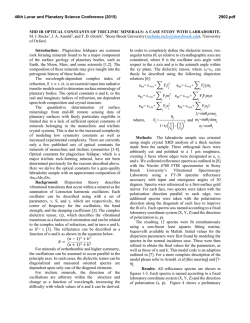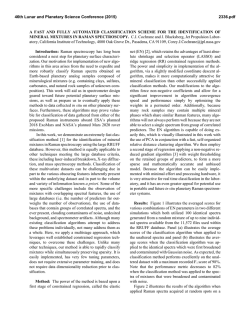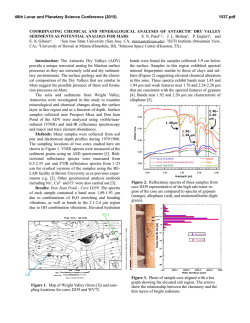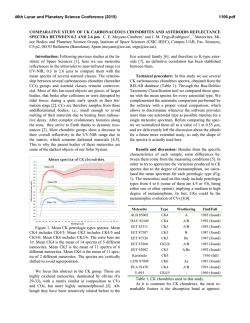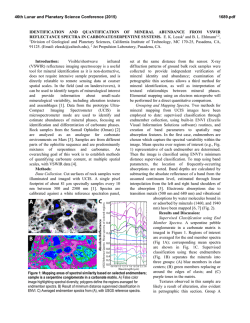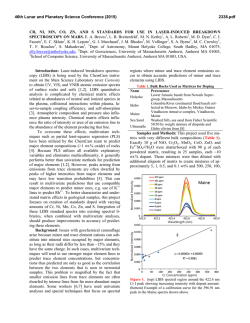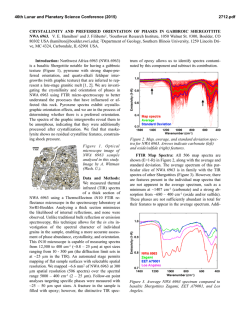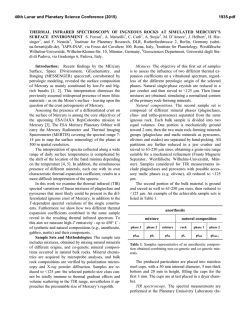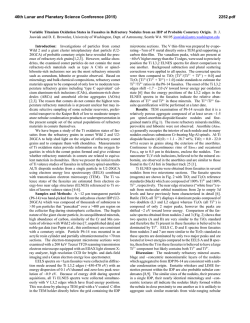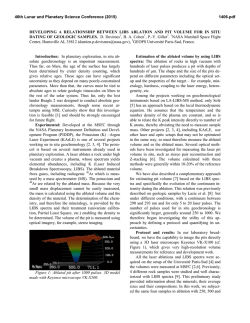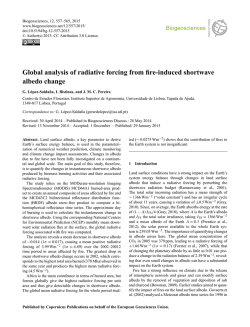
Calculating the Scattering Properties of Fine Particulates on
46th Lunar and Planetary Science Conference (2015) 1535.pdf CALCULATING THE SCATTERING PORPERTIES OF FINE PARTICULATES ON PLANETARY SURFACES. G. Ito1 and T. D. Glotch1, 1Stony Brook University, 255 Earth and Space Sciences Building, Stony Brook, NY 11794-2100 ([email protected]). Introduction: Infrared spectroscopy is a useful tool for remotely analyzing earth and planetary materials. Mid-infrared (~5-50 µm) emissivity is particularly suited for quantitative analysis of bulk silicate mineralogy. Emissivity is dependent on composition, but also on grain size, shape, and packing density [1,2]. For coarse particulates, emissivity spectra add linearly. However, when particulate size is on the order of wavelength of incident radiation, spectra manifest strong non-linearity that hinders accurate mineralogical interpretations. Major spectral changes that occur as particle size decreases include reduction of Reststrahlen band strength, and appearance of transparency features. These nonlinear effects have been difficult to model, and therefore, accurate analysis of mineralogy of planetary surfaces composed of fine particulates has been problematic. To mitigate this problem, radiative transfer models have been used to calculate mid-infrared spectra of fine particulates. Moersch and Christensen (1995) [3] evaluated the effectiveness of different radiative transfer models using quartz and concluded that a Mie/Hapke hybrid model best captures the effect of particle size on mid-infrared emissivity spectra. Mustard and Hays (1997) [4] further used a Mie/Hapke hybrid model to construct reflectance spectra of olivine and quartz, and Pitman et al. (2005) [5] improved on the works of [3] and [4]. Despite these efforts, Mie/Hapke hybrid model has not been able to compute spectra that are fully agreeable with laboratory measurements. Mie theory, incorporated in previous models, provides scattering parameters used to calculate the single scattering albedo and asymmetry parameter, which are the necessary parameters for solving radiative transfer equations. Mie theory is applicable and useful in a sense that it captures diffraction effects, which occur for particulate sizes on the order of wavelength of incident radiation, but makes an assumption that particulates are well separated. This assumption is not necessarily met for planetary studies, such as regolith on the Moon, asteroids and Mars, where particulates are closely packed. This incongruence of Mie theory assumption with the actual setting could be the cause of inadequate modeling by previous studies. In this work, we avoid this problem and calculate more accurate spectra using the Multiple Sphere T-Matrix (MSTM) method instead of Mie theory. MSTM directly solves Maxwell’s equations and is well-suited for multiple scattering caused by many, closely packed particulates such as planetary regolith [6]. Arnold et al. (2012) [7] and Glotch et al. (2012) [8] have proven the usefulness of MSTM method. Here, we expand on their work and highlight the better modeling capabilities of MSTM method by comparing its mid-infrared emissivity spectra to Mie computed spectra and laboratory acquired spectra. Methods: As the MSTM method is dependent on optical constants of minerals, optical constants of three principle indices of enstatite were first obtained from Rucks and Glotch (2014) [9]. A cluster of spheres was generated using a jammed sphere packing algorithm [10], and averaged optical constants were assigned to each sphere at every wavenumber of interest in the midinfrared region. For this study, spheres were assigned a diameter of 10 µm in order to simulate the finest particulates of planetary regolith. Sphere positions, sphere diameter, and optical constants were used as inputs for the MSTM code developed by Mackowski and Mishchenko (2011) [11]. This code is designed to run on parallel computer clusters, and we ran MSTM code on NASA’s Pleiades cluster located at Ames Research Center. Once MSTM computed the necessary parameters, they were input into radiative transfer models presented by Conel 1969 [12], Hapke (1993) [13], and Hapke (1996) [14] to calculate emissivity spectra. All three of these models solve the equation of transfer by the twostream approximation method. We also computed scattering parameters using Mie theory and then input them into the same three radiative transfer models in order to provide a direct comparison to the hydrid MSTM/radiative transfer models. Finally, same enstatite used to obtain optical constants by [9] was ground into powders. Grain sizes less than 10 µm were separated out to measure emissivity spectra using our customized Fourier Transform Infrared Spectrometer. Computed spectra were directly compared with this laboratory spectrum. Results: Computational and laboratory emissivity spectra are plotted in Figure 1. Scattering parameters from MSTM and Mie are input into the three radiative transfer models and are compared to each other as well as to the laboratory measurement. Discussions: The MSTM and Mie methods display significant differences. Both types of computational spectra have a tendency to overestimate spectral con- 46th Lunar and Planetary Science Conference (2015) a. b. c. Figure 1. Computational and laboratory emissivity spectra of enstatite particulates with diameter of 10 µm or less. Models used in computation are Mie and MSTM methods coupled with radiative transfer models of a. Conel (1969), b. Hapke (1993), and c. Hapke (1996). For each plot, laboratory, MSTM, and Mie spectra are shown in blue, green, and red, respectively. trast compared to laboratory spectra. The MSTM method reduces this overestimation and performs better than Mie method. Generally, computational spectra using MSTM more closely follow the laboratory spectrum 1535.pdf than the Mie-computed spectra for all three radiative transfer models. An example of a clear distinction between MSTM and Mie methods is observed at approximately 800 cm-1 (Figure 1). Here the MSTM method computes much more realistic emissivity spectra than the Mie method for all three radiative transfer models. Among the three radiative transfer models, Conel (1969) and Hapke (1996) models perform the best. Moreover, these two models produce almost exactly the same spectra. The Hapke (1993) does not perform as well for this example, and this is likely due to the assumption in this model that heating takes place from above which is not consistent with the conditions under which laboratory emissivity spectra are acquired. Overall, the MSTM method performed better than Mie method, but there is still room for improvement. The greatest mismatch between MSTM and laboratory spectra occurred at wavenumbers above 1200 cm-1 and below 300 cm-1. For these, the relatively small size of the cluster of spheres may be interfering with the scattering process. Increasing the number of spheres could allow better modeling capabilities for these two wavenumber regions. Conclusions: This work demonstrated improved models of emissivity spectra in the mid-infrared using the MSTM light scattering method coupled with several radiative transfer models. By comparing spectra from the MSTM method to the Mie method and laboratory spectra, the outstanding quality of MSTM method was illustrated. However, MSTM is not perfect and more improvements can be made to increase its performance. Our next task is to do this, and in particular, reduce the decrease in emissivity at high and low wavenumbers. References: [1] Hunt G. R. and Logan L. M. (1972) Appl. Opt., 90, 142–147. [2] J. W. Salisbury and Wald A. (1992) Icarus, 96, 121–128. [3] Moersch J. E. and Christensen P. R. (1995) JGR, 100, 7465–7477. [4] Mustard J. F. and Hays, J. E. (1997) Icarus, 125, 145– 163. [5] Pitman K. M. et al. (2005) JGR, 110, E08003. [6] Mishchenko M. I. et al. (1996) J. Quant. Spect. and Radiative Transfer 55, 535–575. [7] Arnold J. A. et al. (2012) LPS XLIII, Abstract #2529. [8] Glotch T. D. et al. (2012) LPS XLIII, Abstract #2652. [9] Rucks M. and Glotch T. D. (2014) AGU Fall Meeting, Abstract #P23B-3987. [10] Donev et al. (2005) J. Comp. Phys., 202, 737–764 (part I) and 765–793 (part II). [11] Mackowski D. W. and Mishchenko M. L. (2011) J. Quant. Spect and. Radiative. Transfer, 112, 2182–2192. [12] Conel J. E. (1969) JGR, 74, 1614–1634. [13] Hapke B. W. (1993) Cambridge Univ. Press, New York. [14] Hapke B. W. (1996) JGR, 101, 16817– 16832.
© Copyright 2026
